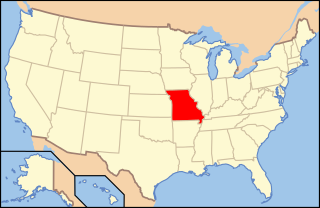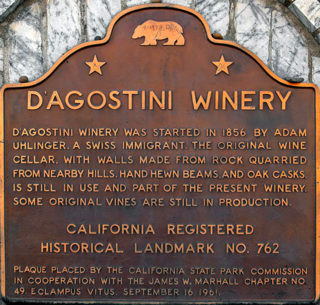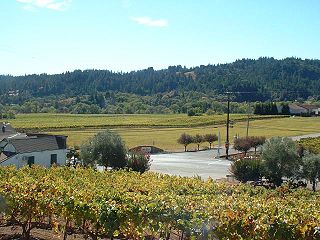Related Research Articles

Rancho Cucamonga is a city located just south of the foothills of the San Gabriel Mountains and Angeles National Forest in San Bernardino County, California, United States. About 37 mi (60 km) east of Downtown Los Angeles, Rancho Cucamonga is the 28th most populous city in California. The city's seal, which centers on a cluster of grapes, alludes to the city's agricultural history including wine-making. The city's proximity to major transportation hubs, airports, and highways has attracted the business of several large corporations, including Coca-Cola, Frito-Lay, Big Lots, Mercury Insurance Group, Southern California Edison, and Amphastar Pharmaceuticals.

Berkeley William Enos, known professionally as Busby Berkeley, was an American film director and musical choreographer. Berkeley devised elaborate musical production numbers that often involved complex geometric patterns. Berkeley's works used large numbers of showgirls and props as fantasy elements in kaleidoscopic on-screen performances.

Wine Country is a region of California, in the northern San Francisco Bay Area, known worldwide as a premier wine-growing region. The region is famed for its wineries, its cuisine, Michelin star restaurants, boutique hotels, luxury resorts, historic architecture, and culture. Viticulture and wine-making have been practiced in the region since the Spanish missionaries from Mission San Francisco Solano established the first vineyards in 1812.

Chile has a long history in the production of wine, with roots dating back to the 16th century when the Spanish conquistadors introduced Vitis vinifera vines to the region. In the mid-19th century, French wine varieties such as Cabernet Sauvignon, Merlot, Carmenère, and Franc were introduced. During the early 1980s, the Chilean wine industry underwent a renaissance with the introduction of stainless steel fermentation tanks and the use of oak barrels for aging. This led to a rapid growth in exports as quality wine production increased. The number of wineries in Chile rose from 12 in 1995 to over 70 in 2005.

The Cucamonga Valley is a region of southwestern San Bernardino County and northwestern Riverside County, in southern California. It is located below the San Gabriel Mountains in the Inland Empire region.

New World wines are those wines produced outside the traditional winegrowing areas of Europe and the Middle East, in particular from Argentina, Australia, Canada, Chile, Mexico, New Zealand, South Africa and the United States. The phrase connotes a distinction between these "New World" wines and those wines produced in "Old World" countries with a long-established history of wine production, essentially in Europe, most notably: France, Italy, Germany, Spain and Portugal.

West Adams is a neighborhood in the South Los Angeles region of Los Angeles, California. The area is known for its large number of historic buildings, structures and notable houses and mansions. It contains several Historic Preservation Overlay Zones as well as designated historic districts.

Missouri wine refers to wine made from grapes grown in Missouri. German immigrants in the early-to-mid-19th century founded the wine industry in Missouri, resulting in its wine corridor being called the Missouri "Rhineland". Later Italian immigrants also entered wine production. In the mid-1880s, more wine was produced by volume in Missouri than in any other state. Before prohibition, Missouri was the second-largest wine-producing state in the nation. Missouri had the first area recognized as a federally designated American Viticultural Area with the Augusta AVA acknowledged on June 20, 1980. There are now four AVAs in Missouri. In 2017 there were 125 wineries operating in the state of Missouri, up from 92 in 2009.

D'Agostini Winery refers to both a winery in Healdsburg, California owned by Armagan Champagne Cellars as well as the original vineyard, winery, and wine cellar located in Plymouth, Amador County, which are owned by Sobon Estate Winery. The original winery is registered as a California Historical Landmark.

Argentina is the fifth largest producer of wine in the world. Argentine wine, as with some aspects of Argentine cuisine, has its roots in Spain. During the Spanish colonization of the Americas, vine cuttings were brought to Santiago del Estero in 1557, and the cultivation of the grape and wine production stretched first to neighboring regions, and then to other parts of the country.

California wine has a long and continuing history, and in the late twentieth century became recognized as producing some of the world's finest wine. While wine is made in all fifty U.S. states, up to 90% of American wine is produced in the state. California would be the fourth largest producer of wine in the world if it were an independent nation.

Italian-American cuisine is a style of Italian cuisine adapted throughout the United States. Italian-American food has been shaped throughout history by various waves of immigrants and their descendants, called Italian Americans.

Agoston Haraszthy was a Hungarian American nobleman, adventurer, traveler, writer, town-builder, and pioneer winemaker in Wisconsin and California, often referred to as the "Father of California Wine", alongside Junípero Serra, as well as the "Father of California Viticulture," or the "Father of Modern Winemaking in California". One of the first men to plant vineyards in Wisconsin, he was the founder of the Buena Vista Winery in Sonoma, California, and an early writer on California wine and viticulture.

Sonoma County wine is wine made in Sonoma County, California, in the United States.

California wine production has a rich viticulture history since 1680 when Spanish Jesuit missionaries planted Vitis vinifera vines native to the Mediterranean region in their established missions to produce wine for religious services. In the 1770s, Spanish missionaries continued the practice under the direction of the Father Junípero Serra who planted California's first vineyard at Mission San Juan Capistrano.

The Cucamonga Valley AVA is an American Viticultural Area in San Bernardino County, California. It is in the Cucamonga Valley region of the Pomona Valley, about 15 miles (24 km) west of San Bernardino.
The Collins College of Hospitality Management is a college part of the California State Polytechnic University, Pomona. Founded in 1973, it was the first hospitality management studies program in California and its thousand students make it the largest such school in the state. As of 2010, The Collins College of Hospitality Management is ranked third in the nation by restaurant executives. Andrew Hale Feinstein is Dean and James A. Collins Distinguished Chair. With approximately 1,400 undergraduate students, the college is the largest of its kind in the country.
Guasti, formerly known as South Cucamonga and Zucker, is a formerly unincorporated community in the Cucamonga Valley region of the Pomona Valley, in southwestern San Bernardino County, California.

Don Pedro Sainsevain was a French-born Californian vintner, ranchero, and a signer of the Californian Constitution in 1849. He is best known for his role in Californian winemaking, as one of the first producers of sparkling wine in California. He also was an early participant in the California Gold Rush.
The history of Los Angeles began in 1781 when 44 settlers from central New Spain established a permanent settlement in what is now Downtown Los Angeles, as instructed by Spanish Governor of Las Californias, Felipe de Neve, and authorized by Viceroy Antonio María de Bucareli. After sovereignty changed from Mexico to the United States in 1849, great changes came from the completion of the Santa Fe railroad line from Chicago to Los Angeles in 1885. "Overlanders" flooded in, mostly white Protestants from the Lower Midwest and South.
References
- ↑ "Guasti Plaza | City of Ontario, California" (PDF). June 20, 2011. Retrieved March 30, 2020.
- ↑ Cal Poly Pomona's Southern California Wine and Wine Industry Collection. "Guides: Southern California Wine and Wine Industry Collection: History of Wine in Southern California". libguides.library.cpp.edu. Retrieved 2020-03-30.
- 1 2 Susan Straight (2012-12-01). "Spirits of Guasti: Between the 60 and the 10". Boom: A Journal of California. 2 (4): 60–67. doi: 10.1525/boom.2012.2.4.60 . ISSN 2153-8018.
- 1 2 Mollno, Linda Frances (2008). Deep Roots and Immigrant Dreams : A Social History of Viticulture in Southern California, 1769-1960. The Claremont Graduate University. p. 140. OCLC 726742142.
- 1 2 "From Penniless Immigrant to 'Wine King'". Los Angeles Times. 2000-10-08. Retrieved 2020-03-30.
- ↑ George M. Walker & John Peragine. (2017). Cucamonga Valley Wine : the Lost Empire of American Winemaking. The History Press. ISBN 978-1-4396-6254-0. OCLC 1012846648.
- ↑ "Guasti Villa - Busby Berkley Estate". LACity.org. Historic Places Los Angeles. Retrieved 8 July 2024.
The property meets the criteria for HCM designation because it is identified with 'a historic personage,' as the home of well-known film director-choreographer Busby Berkeley.
- ↑ "Secundo Guasti". West Adams Heritage Association. westadamsheritage.org. Retrieved 8 July 2024.
After his death, the Guasti family sold the house to film choreographer and director Busby Berkeley.